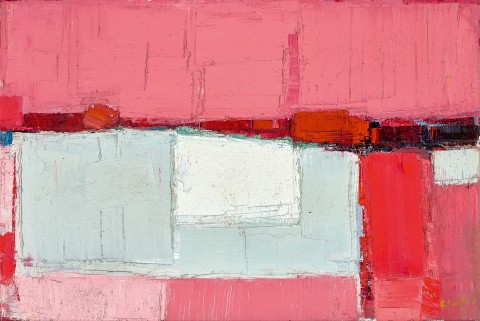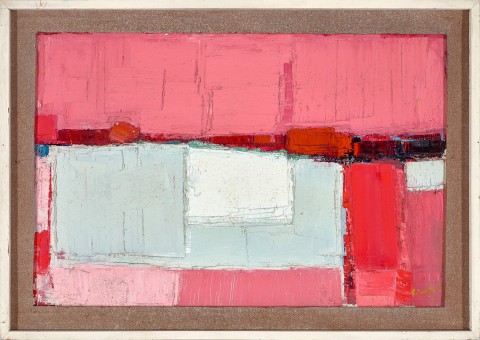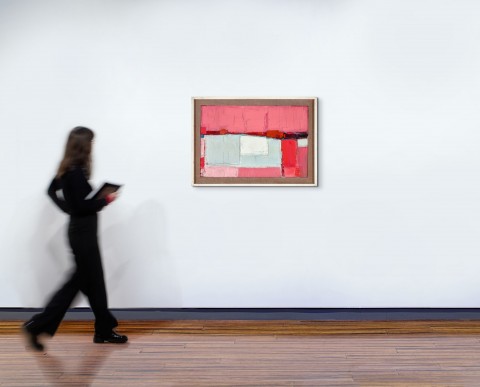SUNLIT PLAIN, 1965
GUY GREY-SMITH
oil and beeswax emulsion on gauze on composition board
61.5 x 91.0 cm
signed and dated lower right: G. Grey Smith / 65
inscribed verso: 8 / GUY GREY-SMITH
in original artist's frame
Private collection, Melbourne, a gift from the artist in 1966
Guy Grey-Smith, Adult Education Board Studio, Perth, 7 - 18 December 1964, cat. 8
Guy Grey-Smith: Paintings, Drawings and Prints, Macquarie Galleries, Sydney, 10 - 19 August 1966, cat. 8
Guy Grey-Smith: Paintings, Argus Gallery, Melbourne, 17 - 28 October 1966, cat. 8
Guy Grey-Smith: A Survey, McClelland Gallery + Sculpture Park, Victoria, 30 April - 2 July 2006, cat. 24 (label attached verso)
Hutchings, P., ‘Guy and Helen Grey-Smith’, The Critic, Perth, vol. 6, no. 11, 28 January 1966, pp. 91 – 92
Gaynor, A., Guy Grey–Smith: Life Force, University of Western Australia Publishing, Perth, 2012, pp. 73, 222 (illus.), 257, 258
Guy Grey-Smith’s luminous Sunlit plain, 1965, has been a treasured piece within a private collection since 1966 when the artist gifted it to his colleague, a highly respected Australian art academic in Perth. Since relocated to Melbourne, the painting has presided for many years above the wondrous clutter of this academic’s desk as a tangible and deeply personal connection to the period when Grey-Smith was truly a national artist of importance – his richly textured, vibrantly coloured paintings bringing the natural wonders of Western Australia to the east coast. Although the exact location of the plain is unknown, in the years 1964 to 1965, Grey-Smith travelled with his family to such diverse places as the Murchison, Roebourne and the De Grey River in the state’s north; Nullagine to the west; and Bunker Bay plus the Stirling Ranges to the south, and it is most likely that the composition was inspired by one of these trips.
Originally trained in post-war England under artists such as Henry Moore and Ceri Richards, Grey-Smith returned to Australia in late 1947, determined to apply all he had learnt into reinterpreting the Australian landscape. By the late fifties, as a result of his allied projects as a potter, printmaker and fresco artist, his style began to simplify with a greater emphasis on the texture of the paint to impart information. His exposure to the paintings of Nicolas de Staël in the early sixties provided the ultimate answer and from then on, his paintings became increasingly powerful and evocative. Thickening the paint with a homemade wax medium, Grey-Smith utilised the trowels he had formerly used for frescoes to apply his pigment in thick slabs, almost tectonic in their forcefulness. At the puckered edges of these – ‘not a delicate fusing of two elements but a collision’1 – Grey-Smith often retained vestiges of underpaint which allowed for chromatic ruptures to contrast new forms. In Sunlit plain, for example, the splash of blue at the middle left and the sage greens on the horizon line allude to the tenacious flora that survives in such parched areas – oases of trees and flowers that have sustained Aboriginal custodians for millennia.
When first exhibited, an extended review described the painting as being ‘perhaps the most interesting picture’ in the show, ‘in uncharacteristic shades of strawberry ice-cream and grey, which sums up the formal pre-conceptions of this artist, and the vibrant feeling which his surfaces so often have… This picture forces two judgements on us at once: it had to come out like that; and it couldn’t come out like that, ever again. The exquisite punctuations of space here suggest a musical pattern, with movements and moments of stillness and of recapitulation. The eye plays the tune to itself.’2 Of further interest is the frame, hand-crafted by the artist, which consists ‘of a single square-edged outer frame 2cm square, and a lower inner slip approximately 5cm wide sawn out of masonite which then had hessian glued to its top surface (the inner edge remained untreated).’3 Given the history of ownership of this painting and its gentle home in the academic’s study, Sunlit plain (and its frame) remains not surprisingly in wonderful condition, with its colours as vibrant today as when first applied by the artist.
1. Harpley, M., Guy Grey-Smith: art as life, Art Gallery of Western Australia, Perth, 2014, p. 12
2. Hutchings, P., ‘Guy and Helen Grey-Smith’, The Critic, Perth, vol. 6, no. 11, 28 January 1966, pp. 91–2
3. Gaynor, A., Guy Grey-Smith: life force, University of Western Australia Publishing, Perth, 2012, p. 251
ANDREW GAYNOR


